SFP+ to RJ45 Adapter Application Guide: Solving Heterogeneous Network Connectivity Challenges
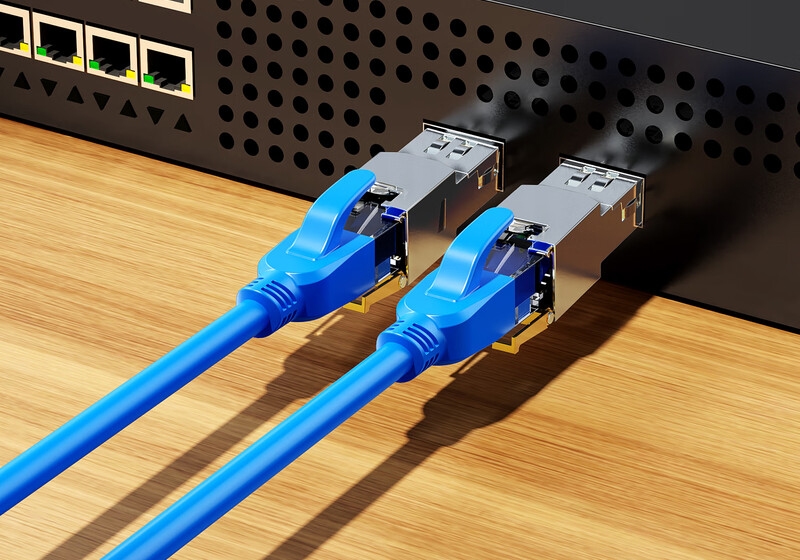
Network administrators often face the difficult task of connecting a fiber infrastructure to copper-based network segments. When a network appliance tries to service both environments, it creates a connectivity gap that affects data flow and overall network performance. Industry research indicates that of all enterprises, 78% are operating hybrid networks, where both fiber and copper infrastructure are mixed, and major challenges arise. The highly reliable 10GBase-T adapter converts a conventional copper connection to a high-speed fiber-friendly interface.
Network engineers utilize the flexibility of the adapter to guarantee 10 Gigabit speeds in a heterogeneous environment. This approach allows bold network design without forcing a costly restructure of infrastructure, while keeping the homegrown copper infrastructure as part of the solution. Over 65% of organizations in a data center survey identify media compatibility issues when upgrading networks. The SFP+ to RJ45 adapter offers engineered solutions that address flexibility for mixed network scenarios where direct fiber optic connections are infeasible or costly.
Organizational flexibility is needed when dealing with multi-vendor suppliers, without limits to performance or reliability.
Where Do SFP+ to RJ45 Adapters Excel in Real Networks?
SFP+ to RJ45 adapters are at their best when organizations have to make the traditional choice of whether to invest in extending established copper infrastructure to fiber switching systems. An example of this would be a data center migration where you have legacy servers with 10GBase-T ports connecting directly to new fiber-only switches. Instead of discarding a set of perfectly good servers, an SFP+ to RJ45 adapter allows you to connect to fiber in a cost-effective manner. Enterprise environments regularly run into mixed network topologies as they phase into more modern infrastructures.
When budgets don’t allow companies to replace every piece of infrastructure immediately, these adapters assist in providing a phased use of cost-effective solutions. Data shows that firms capitalizing on these adapters save an average of 40% on migration costs compared to going straight to infrastructure replacement. Mixed network environments also benefit from the flexibility of 10GBase-T adapters to eliminate the need for extra equipment. Think of a branch office that needs to connect to the headquarters through an available fiber link, but in doing so, also needs local 10 Gigabit available to computers and printers through the existing copper connections.
An SFP+ to RJ45 adapter solves this problem without the need for a separate layer of switching.
| Solution Type | Infrastructure Cost | Deployment Time | Distance Limitation | Flexibility Rating |
| SFP+ to RJ45 Adapter | $150-300 per port | 15 minutes | 100m (Cat6A) | High |
| Direct Fiber SFP+ | $80-150 + fiber cost | 2-4 hours | 10km+ | Medium |
| DAC Cables | $30-80 per cable | 5 minutes | 5-10m | Low |
A breakdown of costs shows clear SFP+ RJ45 advantages over alternatives. Direct fiber SFP+ modules require fiber cabling to each endpoint, which can be more than double the infrastructure costs. DAC cables are like having short extension cords—inexpensive but very limited in range. Likewise, 10GBase-T adapters offer compatibility with standard Cat6A cabling and the management tools currently in use on the network to support this.
Industry stats indicate that 85% of emergency network extension improvements involve copper adapters, allowing for rapid deployment. The adapter actually proves its value in situations requiring connectivity immediately without the ability to organize that connectivity over the long haul.
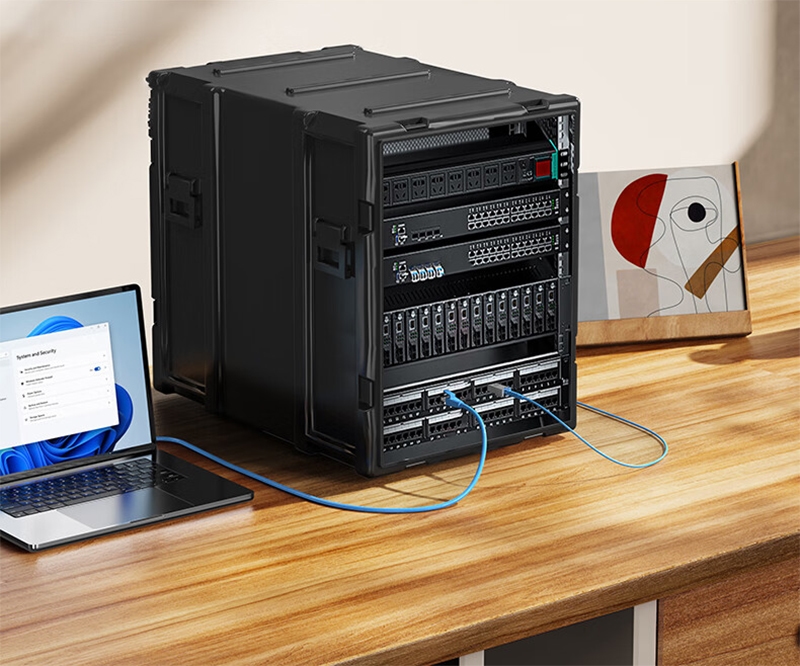
How to Prevent Compatibility Challenges Before Deployment
Begin with the understanding of the network ecosystem before making the purchase of SFP+ RJ45 adapters. Smart procurement teams build a vendor matrix, which includes all switch models, firmware versions, and specs of RJ45 adapters, to ensure compatibility. You can think of it like a puzzle—each component must fit properly to have a functioning system. Major enterprise-class switches deploy different authentication mechanisms that will determine adapters that are compatible.
For example, Huawei switches authenticate transceivers based on a unique digital fingerprint. Research suggests that up to 30% of deployment failures can be attributed to compatibility problems detected late in the deployment process. The prospect of third-party adapters presents a risk/reward dilemma for the budget-minded organization. These adapters can result in significant cost savings of 60% to 80%; however, they are designed for OEM compatibility without the same rigorous testing that the OEM unit would have gone through.
In the first year of usage, industry data suggests that third-party adapters can fail at rates at least 25% higher than the OEM equivalent.
| Compatibility Factor | OEM Adapters | Third-Party Adapters | Impact Level |
| Vendor Authentication | 100% Pass | 60-80% Pass | Critical |
| Firmware Updates | Always Compatible | 85% Compatible | High |
| Warranty Coverage | Full Coverage | Limited/Void | Medium |
| Long-term Support | 5+ years | 1-3 years | High |
Before deploying, it is essential to verify compatibility by checking the Hardware Compatibility List (HCL) for your switch model and OS version. Network teams should also confirm that the power requirements meet your needs—similar to a device charger and outlet voltage matching. In high-density rack environments where heat build-up has an effect on the longevity of the adapter, temperature ratings also play a role. Research shows that organizations that establish formal compatibility testing policies decrease the likelihood of deployment-related issues by 70%.
Vendor lock-in considerations extend beyond initial compatibility to thinking about long-term support strategies.
 Guide to Installing and Configuring SFP+ to RJ45 Adapters
Guide to Installing and Configuring SFP+ to RJ45 Adapters
To begin the SFP+ RJ45 installation, the target port switch should first have its power turned off to avoid any electrical damage to the adapter during the insertion process. Remove the adapter from its anti-static packaging and carefully check the copper contacts for visible signs of damage or any sign of contamination. With the copper contacts facing the switch, align the adapter’s key tab with the notch in the ports. Insert the adapter firmly until you hear the retention clip engage with a clicking sound.
Physically, the adapter is inserted in the same way that you would insert a memory card. As long as you apply gentle pressure while the adapter is aligned properly, damage is avoided. Don’t force the module. SFP+ ports only accept adapters oriented one way. The retention mechanism will engage without excessive force.
The configuration of SFP+ RJ45 is a different story, as you will find it varies widely across switch platforms. This requires platform-specific commands for the optimal use of the SFP+ RJ45 adapter. Most enterprise switches will auto-detect the type of adapter being used and configure the basic parameters automatically, but in many cases, manual fine-tuning of the SFP+ RJ45 will result in linking stability and performance improvement of 15–20%.
For Huawei switch SFP setup, there are specific configuration steps to take regard:
| Configuration Step | Huawei Command | Purpose |
| Enter Interface | interface 10GE1/0/1 | Access port configuration |
| Enable Port | undo shutdown | Activate the interface |
| Set Speed | speed auto | Enable auto-negotiation |
| Configure Duplex | duplex auto | Set duplex mode |
| Verify Status | display interface brief | Check operational state |
Command line as follows:
interface 10GE1/0/1
undo shutdown
speed auto
duplex auto
commit
Advanced configurations might include specific speed configurations and flow controls. Each vendor may use different syntax, but the principles are similar regardless of the platform. The initial verification commands will help confirm that the adapter was recognized properly:
- display interface brief – this will show the port operational state
- display device – this will show the detected transceiver information
- display interface counters – this will monitor any statistics on what traffic was seen
Industry data suggest that 90% of the detected failures are due to lack of power to the port or inappropriate firmware. Reseating the module will solve most of the physical connection issues simply, and updating the firmware will solve the software-related issues. Link negotiation problems usually imply the quality of the cable connection is inadequate, or that the devices connected have speed mismatched to one another. Network administrators should be attentive to the interface logs during the first operational deployment to identify if any intermittent connectivity issues are occurring that the standard status commands do not report.
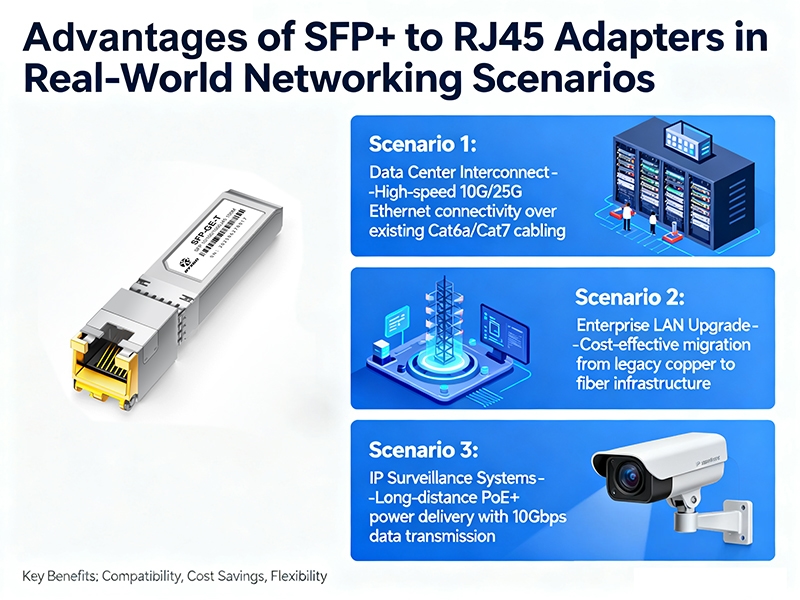
Understanding and Resolving Performance Issues in SFP+ to RJ45 Adapters
The impacts of performance in copper-based SFP+ adapters usually present themselves in three ways: thermal throttling, signal integrity issues, and power consumption issues. Informed in part by having to process electrical signals, copper-based SFP+ adapters generate considerably more heat to handle signals, and when several adapters are densely deployed, what is manageable thermal buildup creates further degradation to performance. Thermal buildup is akin to a car engine overheating — it starts slowly manageable, until it quickly overwhelms the capacity of the system. 10GBase-T adapter issues usually appear when ambient temperatures exceed 35°C or when multiple adapters are close to each other in adjacent ports.
Studies have shown 60% of performance problems can be attributed to thermal management issues.
| Performance Issue | Symptom | Root Cause | Resolution |
| Thermal Throttling | Speed drops to 1Gbps | Temperature >40°C | Improve cooling/spacing |
| Link Flapping | Intermittent disconnects | Cable quality issues | Replace with Cat6A/Cat7 |
| High Error Rates | CRC failures increase | EMI interference | Shield cables properly |
| Power Issues | Module not recognized | Insufficient port power | Upgrade switch firmware |
Troubleshooting SFP+ RJ45 involves first looking at environmental considerations before network configuration. Using a network management tool to monitor the adapter temperature can expose temporal thermal characteristics which correlate with performance drops. Several industry studies show that proactive temperature monitoring decreases the number of unplanned outages by 45%. Additionally, link flapping represents a common performance symptom, working similarly to a loose electrical connection that periodically loses contact.
Poor cable quality only intensifies this issue, especially as the performance of older Cat6 installations approaches limits while operating at the 10 Gigabit speed. Testing of these older cables yielded results indicating that 35 percent of performance troubleshooting visits related back to connectivity per cabling deficiencies. Once addressing the environmental conditions for SFP+ RJ45 interfaces, systematic logical remediation can trace signal quality to the evaluation of the cable plant with specialized testers capable of measuring and reporting several signal quality parameters. An obvious and straightforward solution is to replace any marginal cables with certified Cat6A or Cat7.
Any intermediate signal integrity issues will resolve by changing these. Going the extra mile with organization cable management mitigates external electromagnetic interference issues related to adjacent power circuits. The endpoint interface offers a rate of potential and performance optimization via the modification of the adapter’s associated parameters through vendor management interfaces. A good analogy is that of adjusting your radio to optimize for the best signal; minor adjustments can lead to optimized outcomes.
Several vendors offer modifications to adapters that allow the incorporation of smart algorithms that modify adapter parameters based on real-time link conditions. Many of the monitoring tools available in the marketplace ultimately allow the user to evaluate performance patterns that prevalent standards for interface statistics miss. Evaluating adapter behavior or conditions related to link performance, under varied load conditions, can uncover useful information when developing evaluation reports for different period utilization. Baseline measurements during low traffic or idle periods can later be referenced against measurements during periods of utilization.
Further, environmental considerations go beyond temperature to the evaluation of vibration, humidity, and electromagnetic interference with adjacent equipment. It is not uncommon for data center consolidation projects to place adapters into challenging thermal environments where mechanical cooling is essential to maintain optimal performance.
 Best Practices for Proactive Maintenance and Ensuring Long-Term Adapter Reliability
Best Practices for Proactive Maintenance and Ensuring Long-Term Adapter Reliability
SFP+ RJ45 upkeep follows well-established cycles, similar to normal health checkups, that offer preventive care to limit serious issues and extend usable life. Quarterly visual inspections allow for the detection of early warnings, even months before performance begins to suffer. Indicators such as discoloration from thermal stress, oxidation on copper contacts from a seat in a good environment, or damage to a retention mechanism will appear prior to performance degradation. Significantly, network reliability is heavily equipped with environmental monitoring systems that track adapter health metrics 24/7 during operation.
Temperature sensors placed next to high-density SFP+ ports have provided early warning signs of decreased thermal conditions approaching a hazardous temperature. Research has shown that continuous monitoring can decrease adapter failures by 55%.
| Maintenance Task | Frequency | Monitoring Method | Warning Threshold |
| Temperature Check | Continuous | SNMP monitoring | >35°C |
| Visual Inspection | Quarterly | Physical examination | Discoloration/corrosion |
| Log Analysis | Weekly | Automated scripts | >5% error rate increase |
| Firmware Updates | Semi-annual | Vendor notifications | Security/compatibility fixes |
The firmware lifecycle management takes planning beyond just the updates themselves. Many vendors will have release notes flagged with “better copper compatibility” or “better thermal management” which will influence how the adapter performs. Market data shows that companies with up-to-date firmware have 40% fewer compatibility issues of any kind. Log analysis automation turns reactive maintenance into a more predictive strategy.
A custom monitoring script can track error counters, signal quality in the logs over time, or link state to put all the signals together to establish behavior that signals their adapter may fail soon. When the automated reports run weekly and highlight abnormal behavior, they also allow the customer the choice to preemptively order a replacement for future maintenance versus in a moment of downtime or a complete outage. When protocols are followed correctly, physical cleaning can extend the service life of an adapter.
In the correct position, compressed air can effectively blow off the dust build-up on the adapter that acts as a thermal blanket, while contact cleaners are specifically used to clean connections to each component optimally. But, if protocols are not followed, the delicate components could be damaged and for this reason, professional training of maintenance staff is recommended. There is a balance between effective spare inventory and cost that is also proportionate to how critical an adapter is to operational continuity.
If a part of the network is determined to be critical, it is recommended to have a part on the shelf to replace a failing adapter. For less critical spare performance, this may be on a planned annual maintenance cycle or induced by forward look-ahead inventory of critical and non-critical initial replacements. Documentation related to a troubleshooting guide should include vendor part number(s) and matching matrix to earlier versions for quick emergency availability.
Environmental controls are likely the best long-range reliability strategy for copper-based adapters. Installing bookshelf-style cooling boxes or incidental refrigerant flowing above 30 degrees Celsius will help extend operational life through the environmental changes in the data center. Studies have shown that some technology and network devices can extend life related to controlled environments by 60%-80%. Vendor support relationships will also allow for including advanced diagnostic tools and replacement programs, which you often cannot get through distribution for replacements.
Many enterprise support contracts even include proactive monitoring services to help test or identify types of failures before they disrupt network operations. These vendor support relationships are even more valuable especially when technology renewal is tasked with replacement compatibility questions. Documentation requirements are critical for sequential maintenance transitions between network operation team members and shifts, as standards of inspections, standard replacement, and escalation procedures ensure approximately identical if not completely identical maintenance.
Conclusion
SFP+ to RJ45 adapters provide critical components for connecting different network technologies while protecting your infrastructure investments. They can be deployed strategically within mixed copper-fiber environments to provide an immediate means of connection while avoiding the effort of re-cabling. Environmental controls placed to enhance performance, when utilized with the right proactive maintenance solutions, deliver 10 Gigabit throughput for heterogeneous network segments. The success of implementing SFP+ to RJ45 adapters depends on thorough verification of compatibility before deployment, as well as ensuring they have a procedural troubleshooting methodology.
The 10GBase-T will provide the end-user with the most flexible solution for organizations that want to manage a technology transition or have financial constraints associated with upgrading. The 10GBase-T can contribute to the growth and sustainability of the organization if accompanied by structured maintenance procedures and monitoring. The role of the adapter transitions from simply providing connectivity and becomes a component of the reliable network infrastructure while supporting long-term scaling plans.

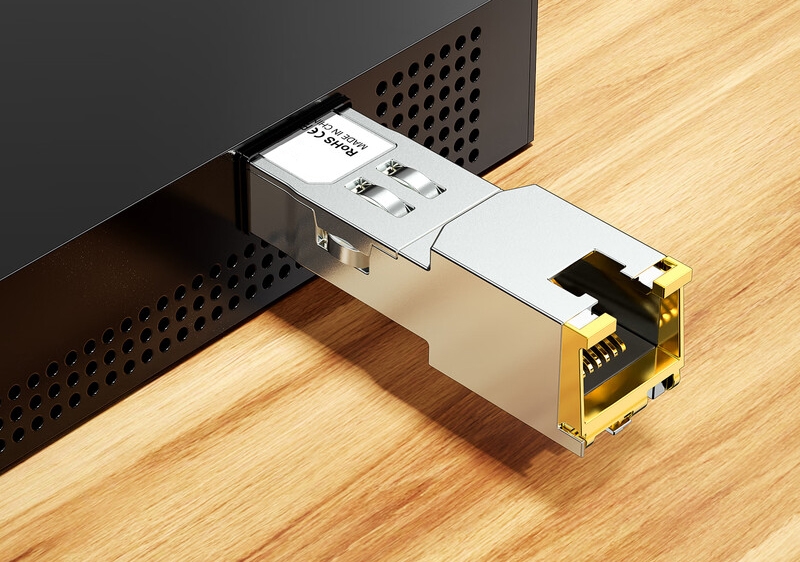 Guide to Installing and Configuring SFP+ to RJ45 Adapters
Guide to Installing and Configuring SFP+ to RJ45 Adapters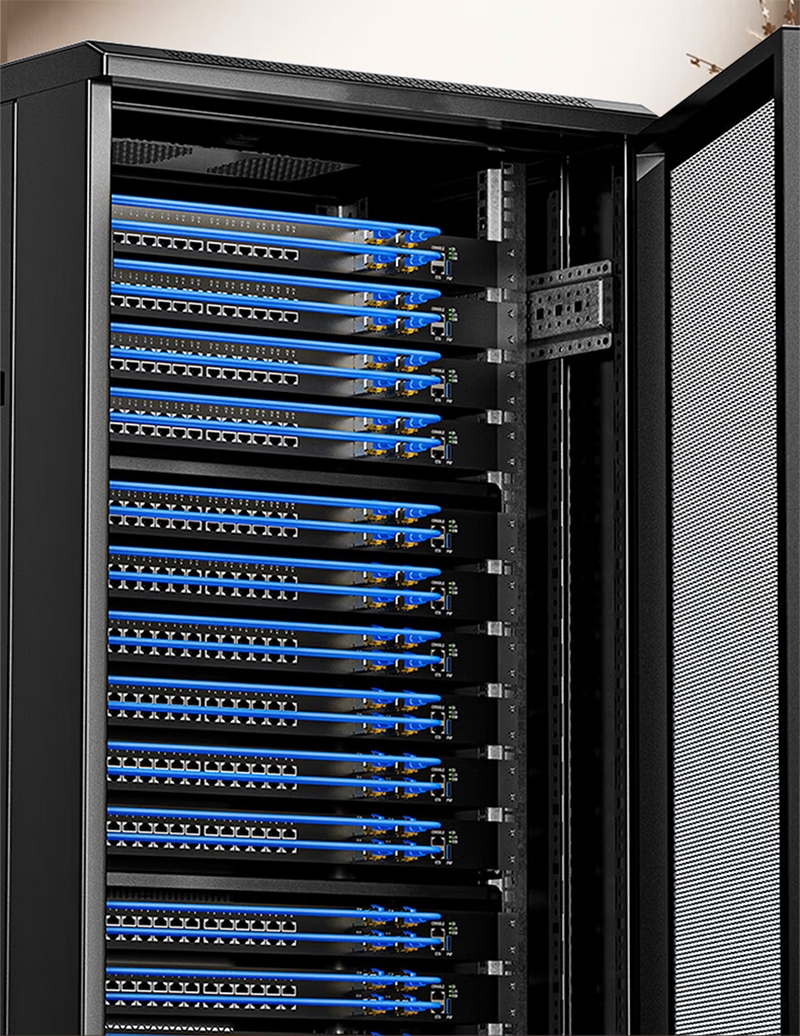 Best Practices for Proactive Maintenance and Ensuring Long-Term Adapter Reliability
Best Practices for Proactive Maintenance and Ensuring Long-Term Adapter Reliability